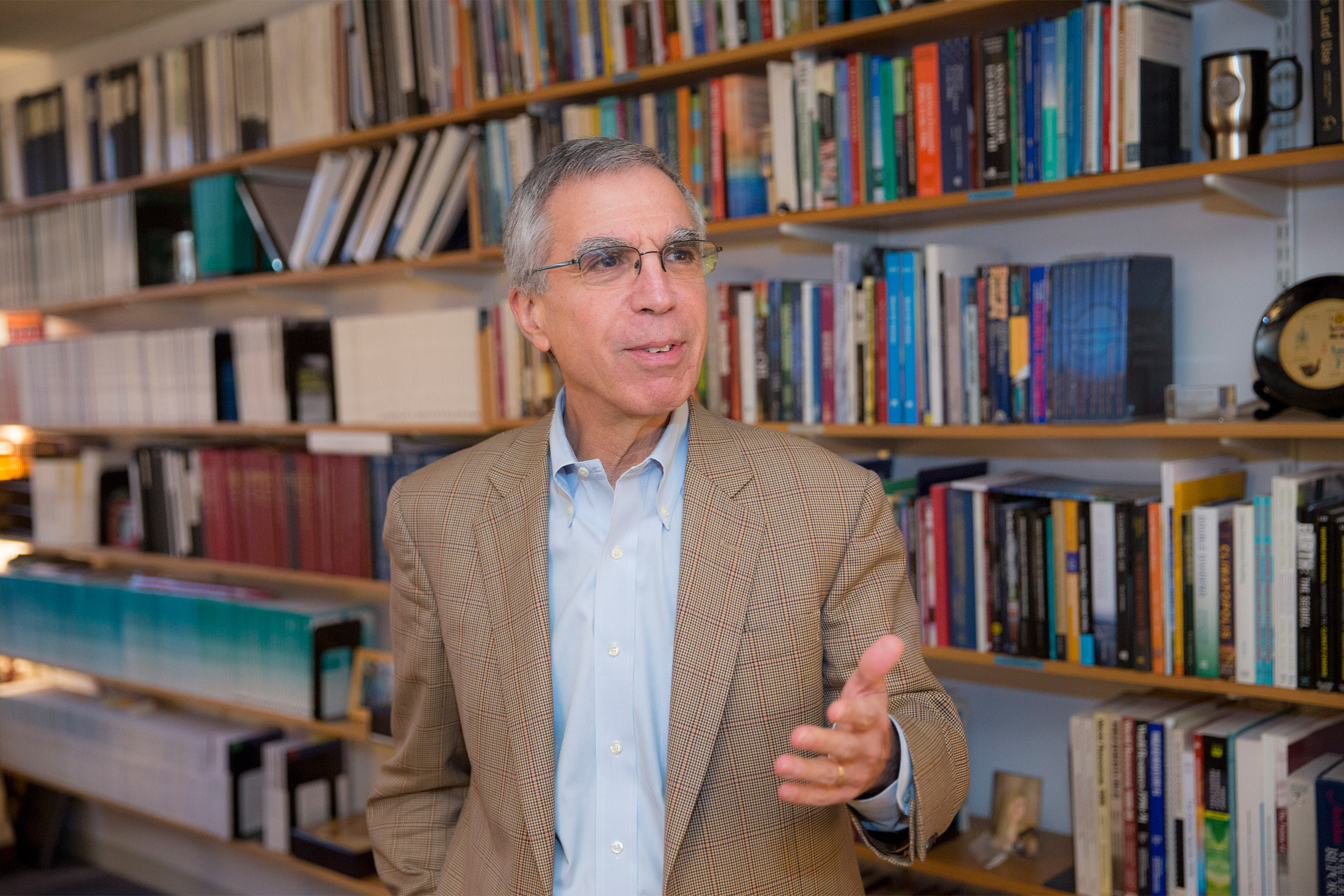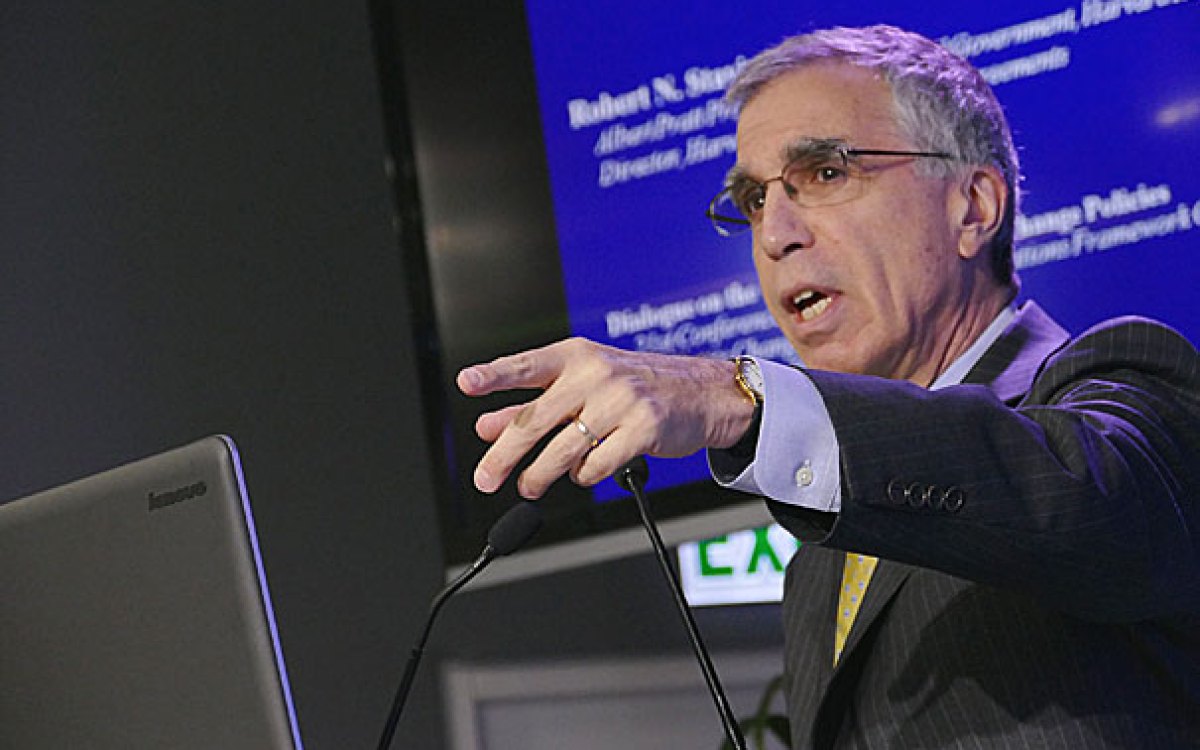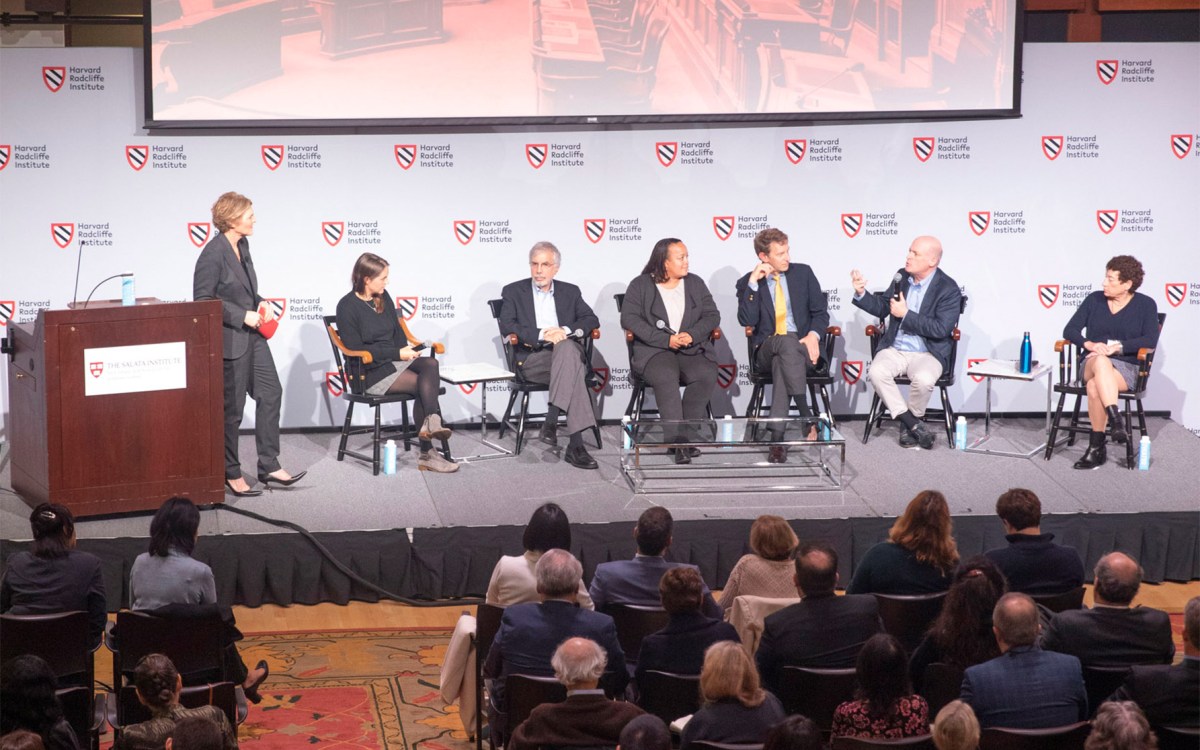
“The most dramatic and contentious decision within the halls of COP27 … was the establishment of a fund for so-called loss and damage. This is an issue that’s been kicked down the road for a long time,” said Robert Stavins.
File photo by Kris Snibbe/Harvard Staff Photographer
Glimmers of movement, hope at COP27
Kennedy School’s Stavins details return of U.S.-China cooperation, creation of loss, damage fund for nations hit hardest by climate change
Climate negotiators from around the world recently wrapped up talks in Egypt that were by turns frustrating and hopeful: frustrating because they did little to accelerate the slow pace of action to reduce carbon emissions, and hopeful because of a reawakened dialogue between the world’s biggest emitters and movement to address climate-related damage to the world’s most vulnerable nations. The Gazette spoke with Robert Stavins, the Harvard Kennedy School’s A.J. Meyer Professor of Energy & Economic Development, director of the Harvard Project on Climate Agreements, and a regular attendee at the annual summits, to better understand successes and failures at the 27th Conference of the Parties to the United Nations Framework Convention on Climate Change.
Q&A
Robert Stavins
GAZETTE: What stands out from COP27, this year’s climate change conference?
STAVINS: Two things stand out, one of which has not been talked about and I think is the most important development for long-term climate policy. The second one is the loss and damage issue. The first is that ever since Donald Trump was elected president in November 2016, a major question has been: When would the United States and China return to what had been a highly effective co-leadership during the Obama years? The Paris agreement would not have been achieved had it not been for the cooperation between China and the United States. That cooperation broke off with Trump and then hadn’t returned under Biden because of disagreements on international trade, human rights, South China Sea, Hong Kong, Taiwan, and other non-climate issues.
At COP27, we got the beginning of the answer, although in surprising fashion. The most important development during COP27 took place 6,000 miles away, in Bali, Indonesia, on Nov. 14. U.S. President Joe Biden and China President Xi Jinping met on the sidelines of the G-20 summit. They shook hands and engaged in a three-hour conversation in which they signaled their return to the cooperative stance that had been so crucial for international progress on climate change. That quickly trickled down to the heads of the respective negotiating teams at COP27, John Kerry for the United States and Xie Zhenhua of China. They’re friends but had not had discussions because of the problems between the two governments. Once the meeting in Bali took place, statements came from both John Kerry and Xie Zhenhua indicating that the two countries plan to resume cooperation, and that they had met and talked several times.
GAZETTE: What makes these two countries so potentially powerful when they work together? Is it just size and global influence?
STAVINS: It’s partially size and global influence, but more specifically, it’s that they’re the two largest emitters in terms of greenhouse gases. Also, the United States has traditionally been the leader of the Western world on many topics, and China — through what is called the “G-77 plus China,” which is 134 developing countries — plays a leadership role in the developing world. These are the two most important constituencies for climate negotiations, and they’re the respective leaders.
GAZETTE: Another theme from COP27 is the failure to increase pledges for emissions reductions by different nations, which was expected after Glasgow. Is that something that could happen because of this U.S.-China cooperation?
STAVINS: Essentially, on every element where there is desired progress, which is feasible and reasonable, China and the U.S. can play a crucial role. They were the first ones out of the gate with their NDCs [Nationally Determined Contributions to emission reductions under the Paris climate agreement] that became a wind at the back of the other delegations. It’s one thing for the European Union to get out in front because they always do. That doesn’t pull a lot of other countries along. It’s one thing for Costa Rica to get out in front among developing countries, but that doesn’t pull a lot of countries along. The United States and China bring a multitude of other countries along when they cooperate and play a leadership role.
GAZETTE: What can you tell me about the new fund for loss and damage?
STAVINS: The most dramatic and contentious decision within the halls of COP27 — by the negotiators from 195 countries — was the establishment of a fund for so-called loss and damage. This is an issue that’s been kicked down the road for a long time. It was first floated in 1991 when Vanuatu, a small island nation in the Pacific, suggested the creation of such a fund to pay for the consequences of rising sea levels, and for 30 years action has been delayed. In COP27, developing countries pushed to establish an explicit fund for this. China came out in favor of an explicit fund for loss and damage, though they also said they weren’t going to put any money into it. The European Union then said they supported it — that was very important — and then a few other developed countries came out in support of it. Then, in the second week of the COP, in a rather dramatic announcement, John Kerry said that the United States was reversing its position. Before the COP started, he said, “We do not support the creation of such a fund.”
GAZETTE: How large will the fund be?
STAVINS: On the demand side, such a fund could eventually amount to trillions of dollars per year. The World Bank estimate of the damages caused by this year’s floods in Pakistan alone is $40 billion. So, if you picture climate change increasing in intensity over time in countries around the world, you can see why it could easily amount to hundreds of billions — indeed, trillions — per year. On the supply side, though, there are very few quantitative pledges thus far: tens of millions of dollars — trivial compared to what the demand is going to be. So, to me, the question becomes: Is the new loss and damage fund an empty shell?
China’s announced position at COP27 was that it supports the creation of the loss and damage fund, but as a “developing country” it will not be responsible for any contributions to the fund. You’ll find a lot of quotes in which they’re self-described as a developing country and what they’re referring to is the definitions of “annex one” and “non-annex one” countries in 1992, under the United Nations Framework Convention on Climate Change. Then, China’s per capita GDP was less than $400 per year. They don’t talk about the fact that per capita GDP in China has grown by 3,330 percent since then.
There’s actually some convergence on the loss and damage fund issue between China and the United States, though not in regard to China’s self-proclaimed exemption from financial contributor status — the U.S. has been outspoken that China should be a contributor. They are not a poor, developing country any longer, they’re a major contributor to the atmospheric “stock” of greenhouse gases — damages are a function of stock, not emissions — and the largest contributor to the annual emissions.
The reason I say there’s convergence is that the United States has a story that puts the United States in a similar place: “We support the loss and damage fund, but due to the new Republican majority in the House of Representatives, it is impossible for us to make any commitment of new funding.” That’s not explicitly stated, but that’s essentially the U.S.’ position. I think that’s why Kerry could make this flip, because there’s no way that there’s going to be any money.
GAZETTE: With the COP over, how do you feel we’re doing? Predictions from the U.N.’s Intergovernmental Panel on Climate Change (IPCC) are getting more dire. People talk about timelines getting shorter. Keeping warming to 1.5 degrees Celsius seems less and less likely.
STAVINS: There have been many statements of disappointment regarding this COP, because the closing statement did not fully embrace the 1.5 degrees C target. But that would have been a nonbinding resolution versus the 2 degrees centigrade target, which is a commitment in the Paris agreement. I may be a glass-half-full guy, but I remember when the IPCC’s business-as-usual estimates of temperature change for this century were as high as 7 degrees centigrade. With the Paris NDCs, they were 3 degrees centigrade. And now, with the new commitments made by countries — including the U.S. — plus the Kigali amendments to the Montreal Protocol, we’re talking about 2.5 degrees C. I recognize that 2.5 degrees is a long way from 1.5, but it’s also a long way from where we were.
GAZETTE: Do you feel relatively certain that the trajectory will continue to improve as we go forward?
STAVINS: I wouldn’t say “relatively certain,” but I’m certainly hopeful. It’s conditional upon political developments in China, in the United States, in the European Union — the other major contributor — but we know where they’re going. China is the big question mark. We have to wait and see. The United States is also a question mark because we flip back and forth between Democratic and Republican administrations and Congresses, which drives the other countries of the world crazy. Russia is also a very large emitter, but has almost removed itself from the discussions, because it has other things to worry about.








